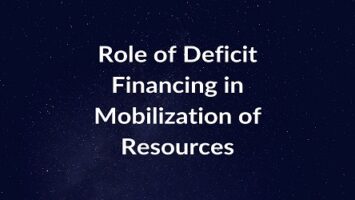Conflicts in Objectives of Budget Policy:
The distinction among the allocation, distribution, and stabilization aspects of fiscal policy is helpful not only in separating more or less distinct policy objectives but also as a guide to fiscal policies. However, the individual and group interests clash in their implementation so that the achievement of one objective is frequently accomplished at the cost of another. Let us now explain the nature of this conflict.
Allocation and Distribution- Consider first, the relationship between allocation and redistribution measures. Redistribution is accomplished most directly through a tax-transfer scheme. It is achieved also by progressive tax finance of the provision for social goods. It means that the provision of social goods is made through a progressive tax-financed scheme which is also helpful in achieving the desired distribution. This is based on an ‘ability to pay approach’ by which the distribution of the tax burden is determined by the ability of the taxpayer to sustain the sacrifice of income reduction, independent of the mix of social goods, which is supplied and the benefit derived therefrom. Because of this, the degree of redistribution tends to depend on the levels of programmes that are to be financed, thus associating extensive provision of social goods with extensive redistribution.
This approach furthered the cause of redistribution when budgets were small and the additional burden could be imposed on high-income recipients. But over time as budgets have increased relative to national income, additional finance had to be drawn more largely from the middle and low-middle income groups, thus reversing this effect. In either case, the linkage between expenditure levels and redistribution does not make for efficiency from the normative point of view. For instance, a person who wants public service should not have to oppose them because he or she dislikes redistribution and vice versa. In other words, a person may like public services but may dislike redistribution measures. Thus, the association of extensive provision for social goods with extensive redistribution breaks down. Hence, a better policy choice will be made, if each issue is taken up on its merit.
Allocation and Stabilization- Let us now discuss the relationship between the allocation and stabilization functions. In times of unemployment, when an expansion in aggregate demand is needed, an increase in government expenditure is often proposed as a remedy. Similarly, in times of inflation, when demand is to be contracted, a case is made for a reduction in such expenditure.
While it is proper for social goods to share in general expansion or restriction of expenditures, there is no reason why they should account for the entire or major part of the change. The stabilizing adjustments can also be made through an increase or reduction in taxes, or a reduction or increase in transfers while leaving the provision for social goods (appropriate at full employment income levels) unaffected.
If the expenditure on the provision of social goods is increased and decreased in unemployment and inflation respectively, it leads to an oversupply of social goods or wasteful public expenditures when expansion is needed; and to a no less wasteful under-supply when restriction is called for. Moreover, when the amount of public expenditure on the provision of social goods is increased to contract unemployment, these expansionary fiscal measures may be opposed by those who oppose high provision for such goods. Similarly, when the amount of public expenditure is decreased to contract inflation, these restrictive fiscal measures may be opposed by those who favor the high provision of social goods. If the issues are separated (that is the provision of social goods is not made dependent on the situation of economic fluctuations), reasonable people may agree on the need for stabilizing action while differing in line with their preferences, on the appropriate scale at which social goods are to be provided. Thus, the conflict between the allocation and stabilization functions of the budget policy is obvious.
Distribution and Stabilization- Now consider the relationship between distribution and stabilization objectives. In the past, it has been argued that during periods of severe unemployment, lower-income groups should be given greater tax relief, since they are likely to spend more of their tax savings than higher-income recipients. The opposite case can be made in times of inflation, namely, that taxes on low-income groups should be raised since they are more potent in reducing demand than taxes on higher income. But, this move has regressive effects and goes against the Justice of taxation and equitable distribution of income. Thus, there is an obvious conflict between the distribution and allocation functions of the budget policy.
Again, proper stabilization action may be interfered with by the redistributional objectives, because the two objectives are linked. However, these arguments cannot be accepted, since the stabilization adjustments can be made with distributionally neutral taxes, or, for that matter any pattern of tax distribution can be accepted, provided only that the overall level of taxation is raised or reduced by a sufficient amount.
Distribution and Growth- Similar problems arise, if a growth objective is introduced. A higher rate of growth may call for a higher rate of capital formation, which calls for increased savings and investment. Since, the marginal propensity to save is higher among high-income recipients than among low-income groups, and since high-income taxpayers undertake most investments, it would seem that the tax structure is such to concentrate on lower incomes. If the tax structure is such that, it concentrates on high-income recipients, it will adversely affect savings and hence capital formation. Again, this conclusion cannot be taken for granted as valid, if public savings are to be made, which for any given tax burden, distribution, may be achieved through high tax rates.
But the conflict may not be resolved as easily if the effects of taxation on investment incentives are considered. Unless a larger reliance on public investment is introduced, a high rate of growth may be in conflict with redistribution objectives.









Comments (No)